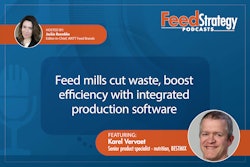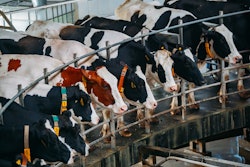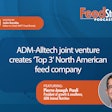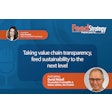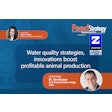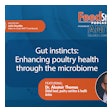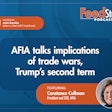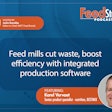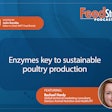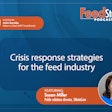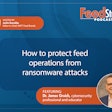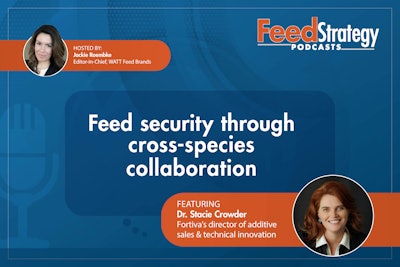
Dr. Stacie Crowder, director of additive sales and technical innovation with Fortiva, joins Feed Strategy Podcast to share her expertise on monogastric health and biosecurity practices. She explores the critical intersection of nutrition and immunity, explaining how feed security has evolved from simply mitigating bacterial threats to addressing viral challenges.
Here, Dr. Crowder offers practical frameworks for evaluating feed additives like medium-chain fatty acids, probiotics and immune modulators, using an illuminating garden analogy to explain microbiome management. The conversation also examines the economic case for health-promoting additives during times of tight margins and looks ahead to emerging nutritional technologies that might transform livestock production globally.
Transcript of interview with Dr. Stacie Crowder, director of additive sales and technical innovation, Fortiva
Jackie Roembke, editor-in-chief, WATT Global Media's Feed Brands: Hi everyone, welcome to Feed Strategy Chat. I'm your host, Jackie Roemke, editor-in-chief of WATT's Feed Brands.
This edition of Feed Strategy Chat is brought to you by FeedStrategy.com. FeedStrategy.com is your source for the latest news and leading-edge analysis of the global animal feed industry.
Today we're joined by Dr. Stacie Crowder, director of additive sales and technical innovation with Fortiva, a Land O'Lakes/Purina Animal Nutrition brand. Dr. Crowder is a swine nutritionist who earned her degrees at Purdue University and has worked at Purina Animal Nutrition in various roles since 2012. Today, she's here to talk primarily about biosecurity and monogastric health, but I'm also going to ask her a few questions about broader nutrition topics, such as feed additive technologies, and her thoughts on some other pressing issues. Hi, Dr. Crowder. How are you today?
Stacie Crowder, director of additive sales and technical innovation with Fortiva: Hello, I'm very well today. Thank you.
Roembke: Excellent. Thank you so much for taking the time out of your busy schedule to speak with me. In the wake of the disease challenges that the poultry industry has been grappling with the last few years, based on your experience, and what you've seen with your customers, what do you think has been the most impactful change to biosecurity protocols that has come as the result of these outbreaks?
Crowder: Yes, thank you for the question. I would say that as an industry, when we started to see the outbreak of diseases that were causing high mortality in the swine industry in early 2013, 2014, was the producers and the nutritionists, so live animal production managers, nutritionists, and health services and veterinarians, came together to really evaluate operational biosecurity and understanding that it's not just biosecurity for animal movement and isolation of animals before they enter the herd or the flock. It's really understanding people movement, animal movement, equipment.
And the one area that we hadn't had really good protocols or a lot of discussion around is this area called feed biosecurity. So it was identified in those discussions that there was a gap. And so this feed biosecurity topic area really rose to the forefront after those breaks. And it came from the meeting of the minds, so to speak, of a nutritionist sitting down with a veterinarian and a live production manager and really understanding we're on the same team and how can we really evaluate the disease pressure and maybe entry points where that could be getting into an operation.
And so that's probably the most exciting thing I saw because in my prior years in the industry as a nutritionist, I never really sat across the table from a veterinarian and really partnered on identifying what maybe the gap or the problem area might be and then coordinating or collaborating on what a possible solution might be.
Roembke: Aside from these very destructive and highly contagious viruses, will you identify some of those endemic pathogens that monogastric nutritionists grapple with and what they should be mindful of when developing feeding programs, in general, and what measures they should maybe be taking to mitigate those disease challenges?
Crowder: Yeah, so when you think about from the monogastric space, I'm going to be a little more skewed towards swine as I've been in that industry longer than the poultry work that I've done. But if I look at the area from swine, it's going to be focused on (porcine epidemic diarrhea virus) PEDv and the (porcine reproductive and respiratory syndrome) PRRS virus. And there's been a lot of work on the feed biosecurity space of looking at the Seneca Valley virus, and then (African swine fever) ASF, of course, as understanding are we prepared and understanding how this disease might impact? And then influenza.
And if we think about from a poultry standpoint in the feed biosecurity space for many years, really thinking of from a Salmonella, so from a bacterial standpoint, we've had avian influenza, the high-path avian influenza (HPAI) work right now with the most current outbreaks, but that has been happening, started before this year. There just seems to be this most current outbreaks right now are extremely in very heavy poultry dense areas. As we think about it, our area of research or most of the feed biosecurity space is focused on what I refer to as ... we focus on the envelope viruses.
There are non-envelope viruses that are less receptive to disinfectants, less receptive to feed mitigation-type technologies, whereas the envelope viruses have a lipid membrane around them, which makes them function very similarly to a bacteria in which they're more susceptible to mitigation technologies or disinfectants.
Roembke: Can you tell us a little bit more about envelope viruses versus what would be in contrast with that type of pathogen?
Crowder: An envelope virus is a virus that has a fat membrane around it. We call that a bilipid membrane. It's very similar to the bacterial membranes. And so why that's important is there are non-envelope viruses and those are less susceptible to disinfectants, less susceptible to feed mitigation-type products in the feed biosecurity space. But that envelope is important because it's how the virus actually replicates or interacts in the host animal. And so the reason we focus on envelope viruses is if we can disrupt that envelope or a bacterial membrane, we can actually inhibit or reduce the infectivity of those viruses. So a lot of the feed biosecurity work will be looking at viral particles and PCR testing and showing that you reduce the amount of viral particles present. If an envelope is disrupted or broken down and the virus is not inside the cell in which it replicates, you in essence reduce its ability to become infective.
Roembke: Thank you so much for that background. I needed that to help frame everything. Now, with the detection of HPAI in dairy herds and how that has put a heightened focus on cross-species disease transmission, based on your experience, what key learnings about pathogen control could poultry producers adopt from other livestock sectors?
Crowder: Yeah, that's actually a great question. And just as much as the advancements we made when I said the nutritionist, the veterinarian, and the live production managers sat down together, it's really interesting and exciting when you can sit down with nutritionists or experts from a ruminant category like a dairy cattle with the HPAI outbreak and a swine nutritionist or a poultry nutritionist and really understand the health challenges and focusing on what's worked in the monogastric space where a lot of feed biosecurity work has been done. And can that translate to the dairy cow and understanding, do any of those products or things in which technologies that we have identified that are effective, can they be effective in that dairy cow?
But transitioning to the poultry industry, I think there's a lot that we can share in that type of interaction between the different species is that there is value to that. Like I said, in early 2013, 2014, when the PEDv outbreak in swine really brought this topic to the forefront, poultry producers had really been focused on mostly, you know, a Salmonella-type of mitigation in the feed and mainly reducing the amount of Salmonella pressure coming into their operation. So they might use a feed sanitation-type technology for that. But there hadn't been a lot of work done on viruses. And so in the research and the development of technology, specifically in my background, we had focused on the swine side and then had actually started looking at a poultry application for those technologies specifically to high-path prior to breaks in 2022, we started looking at high-path avian influenza research.
And so we were prepared at that time to work with the dairy nutritionists and really offer opportunities for them to look at feed mitigation products that actually have an immune response. It's not just that they're reducing the viral or bacterial pressure in the feed, but to really evaluate what mitigation product works best or what's effective against the particular pathogen that you're focused on. It's really, I like to focus on a beyond-the-feeder aspect and when that product or technology is in the animal's diet, that it actually has an immune modulatory response, which can help reduce severity and incidence of disease. And I think when you start to think about the immune system or nutrient digestion of those diets, that's when it doesn't necessarily matter if you're a ruminant nutritionist or a monogastric nutritionist. We can actually talk in the same terms and technologies cross over. Maybe their animals are healthy and at that point you want to get something in. So that'll be a little bit faster of a response.
If you start to notice that, well, I'm starting to see disease outbreak and then you put something in, it's always going to be a delayed response, even longer than that seven to 10-day loading for those technologies to work because now you're at a treatment level. And so once the disease has started in a flock or in a barn, whether that be swine or ruminants, but if your flock's already experiencing disease, then the level of intervention needs to be higher. And then some diseases, there are reportable diseases and then there is rules around how you can handle those after the disease outbreak. So that is going to be things you have to keep in mind when you're looking at evaluating technologies and what works best for which your flock is really going to focus on the disease pressure that that flock is experiencing, as well as what's the environment around that flock that did you want to protect it from.
Roembke: So, switching gears to explore these additive technologies, recently Feed Strategy conducted its annual poultry nutrition and feed survey — so that is our March/April cover story — it's, I think, our 12th year doing it. ... As a nutritionist with a ton of experience in monogastric health, perhaps you can help examine some of these trends with me. One of the findings shows that many of the respondents are adopting multiple gut health strategies simultaneously, e.g. mycotoxin control, precision enzymes, immunomodulators. What key indicators do you look for when determining which interventions are making a positive impact?
Crowder: Yes. So as I look at the different technologies I focus mainly on what is the response I'm wanting to cause if you're talking about gut health, what's actually stealing your performance? So is it inflammatory response at the gut? Is it a dysbiosis or an unbalanced gut microbiome? When you focus from the physiological response that you want to impact, then the technologies really kind of sort themselves of what technology actually has the ability to impact that and metabolic process or specific pathway and the receptors needed.
So if you're thinking of it from an inflammation standpoint or antioxidant status, there are certain different products and whether it's a toxin that's causing the dysbiosis or it's a nutrient utilization where an enzyme can help break that down or it's a low-level pathogen exposure that's causing some insult to the intestinal lining, where then I would be focused more on an immune modulatory and can we have a local response there in the intestines. It really comes back to the physiological function you want, and then you work backwards basically. So instead of what, when I started in the nutrition world, we would have said, oh I need to use this enzyme. I need this type of a phytogenic or plant botanical, and I need this from a yeast-type category.
And they're all going to do these different things and our responses were really varied and it would work one time, but it wouldn't work again. It wouldn't work on dirty litter, but it might work on clean litter or vice versa. And so we got to seeing product ineffectiveness or not seeing a consistent return on investment for the producer. What I've seen in my career and working as a nutritionist and working with nutritionists was focus on the physiological response we want to impact. And that way, your effectiveness or return on investment for that producer is there more consistently. So, that, the focus on the metabolic process you want to impact and then the additive technology or nutritional technology product that actually has the mode of action to elicit the response you're looking for.
Roembke: Great. Thank you. Forty-nine percent of the respondents said that they're turning to synbiotics, which for those not in the know is defined as a mixture of probiotics and prebiotics to promote the growth and activity of beneficial bacteria in the animal's gut. What's the framework for evaluating when to use prebiotics and probiotics together versus alone or in other combinations?
Crowder: Yeah, I would say this is probably a question that I have seen posed multiple times. It seems to be, confusion is not the right word, but it is really understanding what each one of them is doing. So when you think about a prebiotic or a probiotic and that gut microbiome, I like to think out of in terms of, I'm going to use kind of gardening terms, right? You're going to weed, you're going feed, and you're going to seed.
We don't use the same products to weed the garden or to feed it, right? The nutrients or the minerals and things in there. And then when you seed it, you don't use what you use to weed it, right? That's going to kill things off. And so think of it in those terms. And if you are focused on your prebiotic or your probiotic or your postbiotic or all of those category of products or technology spaces is really understanding what you're trying to do and getting a baseline, for where your flock is, where's your flock at today. Where do you see maybe some in understanding there's been a lot of work in the microbiome in poultry and swine to really characterize a healthy balance. So when you look at your baseline for where your flock is, where's that baseline at to the known good and the bad elements there?
And then that's going to give you an impact and interaction to or an understanding thereof the functionality of the microbiome. And if you make changes, what is that going to look like from a functionality standpoint of the microbiome? Then it's going to be all right. I see a high level of a class of bacteria that is known to have a negative impact and I'm seeing slightly less weights or my feed conversions are dropping. Then you're going to really want to come in there and say, all right, do I need to weed it? Do I need to clear out and get rid of some of those negative ones? Do I need to feed the good ones? What's going to make that good bacteria grow? You need to feed that. So understanding how you use the prebiotic products and then seeding it and making sure you have the right population there that can colonize and grow and influence that microbiome.
Roembke: I think that's an excellent analogy. Thank you very much for sharing that. I know that you've done extensive work with medium-chain fatty acids (MCFA). This year, the respondents to the survey indicated that they plan to increase their MCFA inclusions. Are there any special or key considerations for doing this?
Crowder: Yes. here's the, probably the main one is back to what is the purpose or metabolic process or that you're really trying to impact because medium-chain fatty acids are found in multiple forms. When you think about that technology, they are in glycerol forms. They may have, they're a fatty acid stuck to a glycerol backbone. They can be a monoglyceride, a diglyceride, or in a triglyceride form. But the reason you're utilizing the medium chain fatty acid is for the free fatty acid or the functionality of that free fatty acid.
The impact to the animal is going to come later on into the digest state or the digestion process there because you need the pancreatic lipase to break the glycerol off. If you're wanting a product that delivers feed biosecurity or is and it can be an energy source or address pathogens that are in the gut as feeds moving through, then it's not going to be as effective early on in the digestion process. It's going to be later. And so that pancreatic lipase will be your bottleneck. It typically will need higher inclusion levels than the other forms. The second form is that you're going to see this technology offered to producers is in a salt form. So it's going to have a calcium or sodium attached to it. And so that's going to get you activity a little earlier into the digestion, but it's still going to need an acidic environment. In terms of swine nutrition, it's not effective until it hits the stomach so that the acidic environment actually cleaves off that sodium or calcium. In certain species, that can give off a soapy taste and can inhibit intake.
So that's where you need to balance what you're trying to achieve in the animal from the medium chains versus negative impact to the intake. And then there's also products that are what are referred to as free fatty acids or activated medium chain fatty acids that don't require any step. And they're actually going to be effective in the feed, in the stomach, and as they go into the digestion process. They can be immediately absorbed as an energy source. And so really understanding the medium chain category, you have to take those forms into consideration. So if you're looking for something to be impactful in the feed bin, so at the time of manufacturing to the time it reaches your birds, if it would come in contact with any type of pathogen exposure, then that free fatty acid is actually going to be more effective versus if you're looking for a metabolic response or metabolism, then a different product that is effective further into the digestive system can give a benefit in the animal versus in the feed. And so that's how you can sort through the different technologies that a producer may have access to and to determine which one's right for their operations.
Roembke: The high cost of raw materials and feed additives is, of course, an evergreen topic. How do you make the case for producers who prioritize health-promoting additives when tight margins are their primary concern?
Crowder: Yeah, this is kind of the age-old question. I've been in the feed industry since the early 2000s, so for quite a few years. And this is really kind of the paradigm that we've always tried to weigh is understanding. And I'll use kind of an example to think about it. And I mentioned it kind of earlier is gut health. And when you talk about a product that's immune modulatory or gut health. What does the producer see? What does that live production manager see that they can say, it's working, I know it's working?
We need to continue to use it because I see our investment paying off. It's harder to do when it's something that is impacting at the gut level or in the respiratory tract of an animal. You can't see that. That's different. So you're going to need to be looking at your production from all aspects. Is it pounds of product out the door? Your feed conversion rates, when feed costs are super high and volatile, moving around quite a bit. And in our current status of feed ingredients is a lot of additive technologies that are in the feed we import in. And so there's shipping, there's transportation fees as energy costs go up, manufacturing costs. And so as you're evaluating those, I would focus for producers on what is going to return to them the biggest bang for their buck.
So I like to say products that give you extra gain those are valuable when you need the gain. So they're only valuable when you're going to put a dollar amount of return to that gain. But feed conversion pays you every day. Feed conversion translates to less feed needed to get the animal to a particular weight, which translates to less feed needs to be manufactured, which translates to less feed needs to be hauled. So when you think about how much a feed conversion response impacts a producer's bottom line, if they're a large integrator and they have their own feed system, are you thinking about the savings at the feed mill? Less feed that needed to be manufactured. You're taking your valuable resource of those grain inputs into the diet, stretching them over a larger number of birds or a larger number of pigs. And so you can spread that kind of cost out and really looking at it as an operational efficiency and making sure you're not missing an evaluation or not giving enough credit to that technology.
I really work with producers on understanding what is their true ROI. And ROI is different for every producer. On the swine side, we've got facility costs. They may own that facility, they may not. And so is it income over facility costs? Is it income over feed costs? And so really, I think it really needs to be as a nutritionist at a poultry operation or a live production manager that's managing their input cost is really evaluating the impact to their entire system. And is it better birds hitting the processing line? Is it, I like to talk on the swine side, it's more pounds of pork walking out the door. And those silent thieves, you can't see how much it's stealing from you, but you can measure that in certain times of the year where you got less pork walking out the door. If you can have a slight reduction in mortality, you can actually impact it because that's one or two more pigs walking out the door. That's they're going to be 280 to 300-plus pounds. And so you talk about that pounds of pork walking out the door. On a poultry operation, it's the pound of product that leaves your facility. And so think of it in those terms. And I think it'll be an easier evaluation.
Roembke: With sustainability goals increasingly influencing feed formulations, how do you balance the environmental impact of production with optimal monogastric health and performance?
Crowder: I think every monogastric nutritionist probably is thinking, I really want to hear what our answer is to this one, because it is a topic that we're spending a lot of time understanding. As a nutritionist, when we formulate, we're used to looking at formulation and what each ingredient brings to the table from a nutrient standpoint. I was taught early on in the industry when I joined, animals don't need ingredients, they need nutrients.
Understanding what each ingredient in the diet brings to the table from either a nutrient availability or nutrient absorption level, so bioavailability, or does it impact another ingredient, like an enzyme would impact other ingredients being more useful. The piece that we're trying to build out right now is what is that sustainability impact? On the dairy side, there's been a lot of talk on methane reduction. So are there things that we can do that we feed to the animal that actually reduces the methane production and impacts that digestion? So then there would be a sustainability value to that ingredient. When we think about it from the monogastric side, I'll go back to my feed conversion response conversation of understanding products and that especially in the additive category that may not have a nutrient matrix behind them and understanding, is there a sustainability matrix? Is there a sustainability index that this product has three points of feed conversion or what does one point of feed conversion mean on a sustainability index? And so the industry is actually developing what those technologies might be or how they're going to be evaluated. So I would say stay tuned.
But I try to look at from a reduced use of resources and can I stretch your feed dollar to spend like a dollar and a half or spend like two dollars. So can I make one plus one equal three? Not because I'm bad at math, but because I want us to get a multiplying effect. If I'm using a technology, I want it to multiply the effect of what I'm already using, not to duplicate.
And so when you think of it in those terms, that's really what a nutritionist, if we look into the future, is really going to have to be prepared for is I think we're going to evaluate all ingredients, not just additive technologies, but kind of total diet makeup. And what is the environmental impact? We kind of did this a little bit in the swine industry when we started looking at the value of manure. and using manure as a fertilizer or selling it to farmers as a fertilizer replacement for certain things that they might be adding on to their row crop operation. But this is taking it to a whole new level.
What does this nutrient profile based on that, the animal performance associated with it, then what is that sustainability index? What does that mean? And I think a lot of that still, we don't know. We don't know what it means. We're working that out. We kind of understand what it means from a feed conversion or average daily gain standpoint. But what does that mean on a sustainability index? And can we actually help the producer understand, is it valuable? Can we monetize it? There's a lot of talk on carbon reductions and those types of things. I think that's just the tip of the iceberg in this space.
Roembke: We've covered a lot of ground today. And given some of the things we've discussed and of course your experience in the industry and the things that you're probably looking at and following in your own time, what emerging technologies or nutritional strategies excite you the most when you're looking to the future and some of the developing areas for some of these challenges?
Crowder: That's kind of a loaded question for someone that sits in my seat that is kind of responsible for additives across multiple species. I have a lot of things that pique my interest. I think the ones that are most exciting to me, because I am a scientist, right? I've done a lot of research. And so when I where I can geek out on the science and really get behind a technology is when I think this immune modulatory space is very interesting to me. So from a nutritionist, you think, OK, well, that that's probably a veterinary term.
Everybody talks about immune system and medications, right? I've really taken a different approach to it. And why it excites me is that 70% to 80% of the animal's immune system is in the gut. And so I feel like there are space and opportunity from a nutrition standpoint to understand the immune response of immune receptors and how they respond to dietary components. And I think that's where we're going to see a lot of advancements is especially I've seen it even in the last five years since the (veterinary feed directive) VFD took effect on diet. In 2017, where we started really sharpening our pencil on production and nutrition and the impacts of it and not having that, putting medication in the feed as an automatic, oh, I see something, so let's put that in there.
I've seen so many advancements from a gut health standpoint or an enteric disease. What excites me is I believe there's technologies that impact respiratory. And that's been the nut that's a little harder to crack because how can we feed something that gives us a systemic response that actually reduces respiratory challenges? And I'm seeing a lot of research be published. I'm seeing a lot of advancements here in the space of some of the technologies we've talked about on this conversation that are promising technologies that I think are actually going to change the way we raise livestock, especially in the United States, but even globally.
These are global technologies that impact across the world. And getting more out of less, we're going to have to do more of that. I don't think anybody thinks that we're going to find more land that we can do agriculture on. So I think the advancements of respiratory disease and enteric diseases that we can actually mitigate with nutritional technologies, that excites me a lot.
Roembke: Thank you so much, Dr. Crowder, and thanks to you for tuning in.



